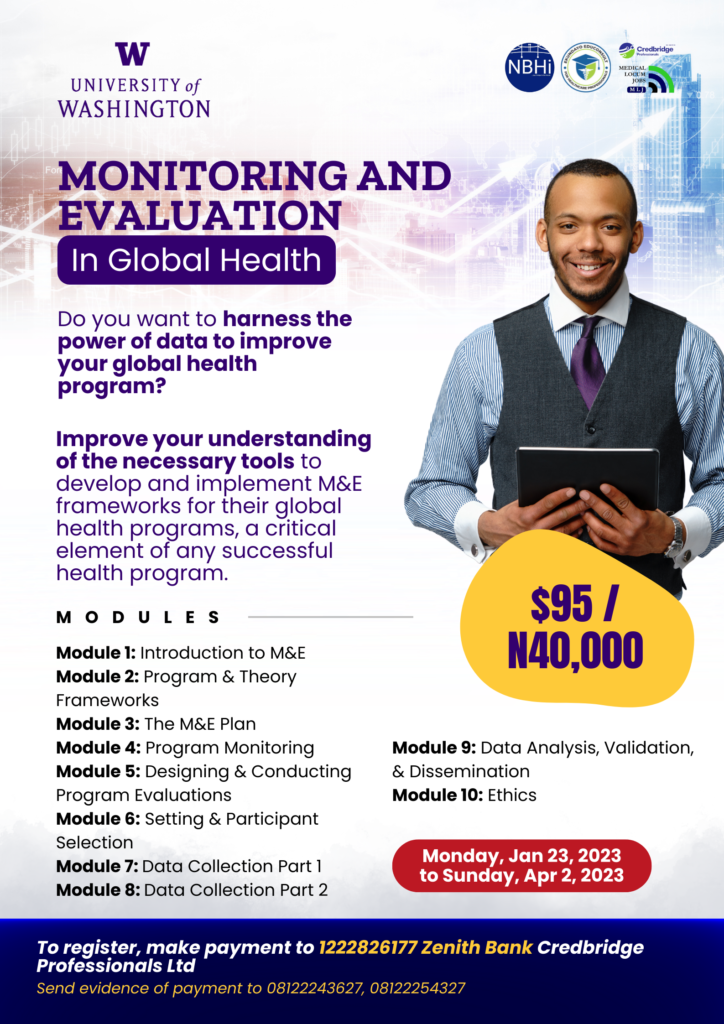- +234 70 4149 7660
- info@ekundayoeduconsult.com
- Lagos Nigeria
Monitoring Evaluation Global Health
Monitoring and Evaluation of Global Health


PAYMENT AND REGISTRATION DETAILS
Company’s Account
1222030790
Zenith Bank
Ekundayo Educonsult for Healthcare Professionals.
Domiciliary Account
3184967233
First Bank of Nigeria
Mustapha Yusuf Ekundayo
For International Students
Any of the options below can also be used
– Western Union
– Money gram
– World Remit
– Mukuru, etc
Send proof of payment through our WhatsApp Chat Icon visible on every page
Monitoring and Evaluation of Global Health
Introduction: Why Monitoring and Evaluation Are Essential in Global Health
Monitoring and Evaluation (M&E) are indispensable components of global health programs, ensuring that resources are used effectively and that desired outcomes are achieved. In a sector where every dollar and action count, M&E provides a systematic approach to track progress, assess impact, and inform decision-making.
This article dives deep into the principles, tools, and strategies of Monitoring and Evaluation in Global Health, offering insights into how these practices can enhance accountability, improve outcomes, and drive sustainable health interventions.
1. Understanding Monitoring and Evaluation
1.1 What is Monitoring?
Monitoring involves the continuous collection of data during a project to ensure that activities are on track and resources are being used as planned.
1.2 What is Evaluation?
Evaluation assesses the effectiveness, efficiency, and impact of a project after its implementation, helping stakeholders learn from outcomes and refine future strategies.
1.3 Why M&E Matters in Global Health
- Accountability: Demonstrates responsible use of resources.
- Learning: Provides insights for improving program design.
- Impact Measurement: Ensures interventions achieve their intended goals.
2. Key Principles of M&E in Global Health
2.1 Relevance
M&E activities must align with the goals and objectives of the program to provide meaningful insights.
2.2 Participation
Engage stakeholders, including communities, in M&E processes to enhance accuracy and buy-in.
2.3 Transparency
Share findings openly to build trust and encourage collaborative improvements.
2.4 Adaptability
Programs should be flexible enough to respond to M&E findings and adjust strategies as needed.
3. Tools and Frameworks for M&E
3.1 Logical Framework (LogFrame)
- Helps outline project goals, activities, and expected outcomes.
- Provides a structured approach to M&E planning.
3.2 Results-Based Management (RBM)
- Focuses on achieving outcomes rather than simply completing activities.
3.3 Key Performance Indicators (KPIs)
- Measure progress and success quantitatively. Examples include immunization rates or disease prevalence reductions.
3.4 Data Collection Tools
- Surveys and questionnaires.
- Focus group discussions.
- Mobile data collection apps like KoBoToolbox or ODK.
4. Challenges in M&E for Global Health Programs
4.1 Resource Constraints
Limited funding and personnel can hinder comprehensive M&E efforts.
4.2 Data Quality Issues
Inconsistent or inaccurate data affects the reliability of findings.
4.3 Cultural and Political Barriers
Cultural norms and political contexts can influence data collection and program evaluation.
4.4 Complexity of Health Interventions
Global health initiatives often involve multifaceted issues that are difficult to measure.
5. Best Practices for Effective M&E
5.1 Define Clear Objectives
Ensure all stakeholders understand the goals of the M&E process.
5.2 Use Mixed Methods
Combine qualitative and quantitative approaches to capture comprehensive insights.
5.3 Build Capacity
Train local staff and partners to ensure sustainable M&E practices.
5.4 Integrate Technology
Adopt digital tools for real-time data collection and analysis.
6. Case Studies: Successful M&E in Action
6.1 Polio Eradication in Nigeria
Effective M&E helped track vaccination coverage and address gaps, contributing to Nigeria being declared polio-free.
6.2 HIV/AIDS Program in Kenya
Data-driven evaluations identified successful strategies for antiretroviral therapy distribution, improving patient outcomes.
7. M&E Training Opportunities with Ekundayo Educonsult
7.1 Monitoring and Evaluation Fundamentals
Learn the basics of designing and implementing M&E frameworks.
7.2 Advanced Data Analysis for M&E
Master data visualization and statistical tools for in-depth program analysis.
7.3 Technology Integration in M&E
Discover how digital tools can transform monitoring and evaluation processes.
8. The Role of M&E in Achieving Global Health Goals
8.1 Sustainable Development Goals (SDGs)
M&E is critical for tracking progress toward global health-related SDGs, such as universal health coverage and reduced maternal mortality.
8.2 Health Equity
Regular evaluations help identify and address disparities in health access and outcomes.
8.3 Innovation in Healthcare Delivery
M&E findings can inspire new approaches to tackle persistent challenges.
9. How to Get Started with M&E in Global Health
- Step 1: Understand the program’s goals and objectives.
- Step 2: Develop a comprehensive M&E plan, including data collection and analysis methods.
- Step 3: Engage stakeholders and ensure capacity building.
- Step 4: Use findings to refine strategies and improve outcomes.
10. Contact Ekundayo Educonsult for M&E Expertise
- Phone: +234 (XXX) XXX-XXXX
- Email: info@ekundayoeduconsult.com
- Website: www.ekundayoeduconsult.com
Conclusion
Monitoring and Evaluation are the bedrock of successful global health interventions. By adopting robust M&E practices, organizations can ensure accountability, improve program effectiveness, and make a lasting impact on global health challenges.
At Ekundayo Educonsult, we specialize in equipping professionals with the skills and tools needed to excel in M&E. Whether you’re new to the field or seeking advanced training, we’re here to support your journey.
Take the first step toward making a difference in global health. Enroll in our M&E training today!
